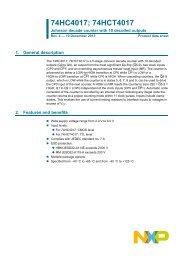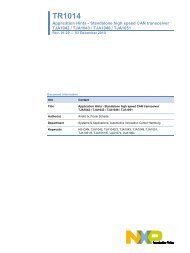75W SMPS with TEA1507 Quasi- Resonant Flyback controller - NXP ...
75W SMPS with TEA1507 Quasi- Resonant Flyback controller - NXP ...
75W SMPS with TEA1507 Quasi- Resonant Flyback controller - NXP ...
Create successful ePaper yourself
Turn your PDF publications into a flip-book with our unique Google optimized e-Paper software.
Philips Semiconductors<br />
Application Note<br />
AN00047<br />
VF = forward voltage drop of diode<br />
I(opp)(demag) = current threshold of OPP protection (-24μA)<br />
3.4.4 Short Winding Protection<br />
The short winding protection is implemented to protect against shorted transformer windings, for example in case of<br />
a secondary diode short. In this case the primary inductance is shorted out and the primary current starts to rise at<br />
very high rate (only limited by the leakage inductance) after turn on of the MOSFET. An extra comparator (fixed<br />
threshold of Vswp = 880mV) implemented in the IC will detect this fault condition by sensing the voltage level (via pin<br />
5) across the sense resistor. Immediately the driver is disabled and the <strong>controller</strong> enters the Safe-Restart mode.<br />
This protection circuit is activated after the leading edge blanking time (LEB).<br />
3.4.5 Minimum and maximum ‘on-time’<br />
The LEB (Leading Edge Blanking) time is an internally fixed delay that determines the minimum ‘on time’ of the<br />
<strong>controller</strong>. This minimum on time together <strong>with</strong> the minimum switching frequency and the primary inductance<br />
defines the minimum input power at which the output voltage is still in regulation. Because this minimum frequency<br />
is low it is possible to run at extremely low loads (<strong>with</strong>out any pre-load).<br />
The IC will protect the system against an ‘on-time’ longer then 50μs (internally fixed maximum ‘on-time’). When the<br />
system requires on times longer than 50μs, a fault condition is assumed, and the <strong>controller</strong> enters the Save-Restart<br />
mode.<br />
3.4.6 Over Temperature protection<br />
When the junction temperature exceeds the thermal shutdown temperature (typ 140°C), the IC will disable the<br />
driver. When the VCC voltage drops to UVLO, the VCC capacitor will be recharged to the V(start) level. If the<br />
temperature is still too high, the VCC voltage will drop again to the UVLO level (Safe-Restart mode). This mode will<br />
persist until the junction temperature drops 4 degrees typically below the shutdown temperature.<br />
3.4.7 Mains dependent operation enabling level<br />
To prevent the supply from starting at a low input voltage, which could case audible noise, a mains detection is<br />
implemented (Mlevel). This detection is provided via pin 8(no additional pin needed), which detects the minimum<br />
start-up voltage between 60V and 100V. As previous mentioned the <strong>controller</strong> is enabled between 60V and 100V.<br />
This level can be adjusted by connecting a resistance in series <strong>with</strong> the drain pin, which increases the level by<br />
R1⋅Iin(Drain) volts.<br />
An additional advantage of this function is the protection against a disconnected buffer capacitor (CIN). In this case<br />
the supply will not be able to start-up because the VCC capacitor will not be charged to the start-up voltage.<br />
3.5 Burst mode Stand-by<br />
Burst mode can be used to reduce the power consumption below 1W at stand-by. During Burst mode the <strong>controller</strong><br />
is active (generating gate pulses) for only a short time and for a longer time inactive waiting for the next burst cycle.<br />
In the active period the energy is transferred to the secondary and stored in the buffer capacitor CSTAB in front of the<br />
linear stabilizer (see Figure 9). During the inactive period the load (e.g. microprocessor) discharges this capacitor.<br />
In this mode the <strong>controller</strong> makes use of the Safe-Restart mode.<br />
16






